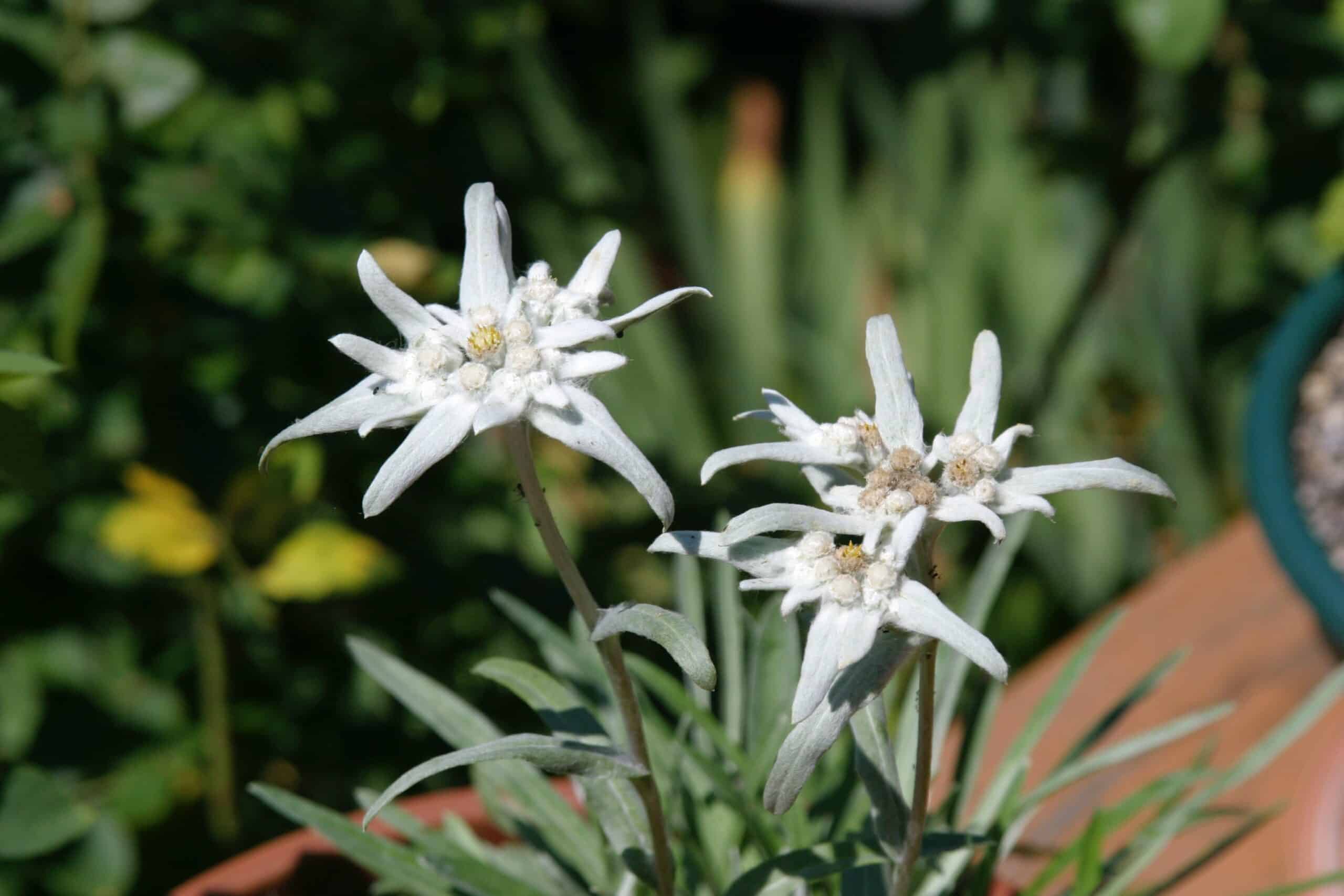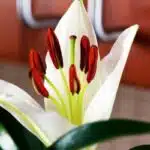Do you feel like you are walking on clouds when admiring the beautiful Edelweiss flower? This alpine beauty is a symbol of courage and love, and it’s the perfect addition to any garden. This article will serve as your guide to growing and caring for Edelweiss flowers, so you can capture its ethereal grace in your own backyard.
When it comes to growing Edelweiss flowers, knowledge is power. As a specialist in botany and gardening, I am confident that with the right information, anyone can be successful in growing this stunning bloom. Aside from providing detailed instructions on how to properly cultivate these delicate blooms, this article will also equip you with the necessary tips for keeping them healthy throughout their lifetime.
Finally, it’s important to remember why we grow Edelweiss flowers in the first place: to bring joy into our lives. With their breathtakingly soft petals and vibrant colors, these flowers will be sure to spark that inner desire for serving others – a subconscious need that many of us share but may not even realize!
What Is An Edelweiss Flower?
Ah, the Edelweiss flower! This alpine gem has enchanted people for generations with its soft white petals and star-shaped center. But what is it really? How do you grow and care for this fragile flower? Let’s find out!
As a specialist in botany and gardening, I’m here to tell you that the Edelweiss flower is a perennial plant native to Central Europe. It’s also known as Leontopodium Alpinum or ‘Lion’s Foot.’ This plant can reach heights of up to 30 centimeters and blooms from June to September. On top of this, Edelweiss is frost resistant and can survive temperatures as low as -20 degrees Celsius!
The key to growing and caring for an Edelweiss flower lies in understanding its growing requirements. The plant needs full sun exposure and well-drained soil with plenty of organic matter. Additionally, it should be planted in early spring or late fall, preferably spaced at least 2 feet apart from other flowers so they have enough room to grow. Finally, make sure to water the plants regularly during dry periods but avoid overwatering them since they don’t like wet soil.
To conclude, while Edelweiss flowers may seem delicate due to their appearance, they are surprisingly resilient when given the right conditions. With proper care and attention, these beautiful blooms will bring years of joy and beauty into your garden.
Understanding Edelweiss Flower’s Growing Requirements
To get the most out of an edelweiss flower garden, it is essential to understand its unique growing requirements. With a bit of know-how, even novice gardeners can hit the ground running and create a lush oasis of these beautiful white blooms. Let’s dive right in and get to grips with how to make your edelweiss flourish like never before.
First and foremost, edelweiss flowers are mountain dwellers by nature. As such, they require well-draining soil that is highly alkaline and neutral in terms of pH levels. To ensure this environment, consider adding gypsum or lime to the soil prior to sowing seeds or planting cuttings – a great way to get off on the right foot! Planting in raised beds is also an effective solution for achieving these conditions; this will help avoid possible drainage problems which can occur on sloping terrain.
In terms of water needs, edelweiss plants are surprisingly resilient – too much water can be just as detrimental as not enough! They need a consistent supply during their active growing season (typically late Spring through Summer), but if planted correctly they should be able to withstand dry spells without any problems. That being said, regular watering during hot spells will encourage more vibrant flower growth and enhance overall health of the plant.
Now that we have discussed some key points about edelweiss’ preferred growing conditions, let’s look at how we can select an ideal spot for them in our gardens.
Choosing The Right Location For Edelweiss
Selecting the spot for edelweiss is a significant step in its successful cultivation. Planting edelweiss in the proper place is essential for it to prosper and thrive. As a specialist in botany and gardening, I can confidently reveal that careful consideration should be given when deciding where to place edelweiss.
First and foremost, edelweiss prefers full sunlight. It needs more than six hours of direct sunlight every day to remain healthy. If planted in partial shade or under a tree, the flower will struggle to survive and will likely die prematurely. Hence, it’s important to carefully select an area that is exposed to direct sunlight most of the day so that your edelweiss can bloom beautifully.
Additionally, edelweiss prefers an area with well-drained soil which helps keep the plant healthy by avoiding root rot due to excess moisture. The soil should also contain adequate nutrients for the flower’s growth. Be sure to test your soil prior to planting your edelweiss so you can determine if additional fertilizers are needed or not. Also take into account whether or not there are any potential pests or diseases that could harm your flower before planting it in a particular location.
The perfect place for growing edelweiss is waiting–all you need now is some soil preparation! After selecting the right site, you’ll need to condition the soil properly so that the roots of your Edelweiss have enough room to expand and absorb nutrients from their environment efficiently.
Soil Preparation For Edelweiss
Soil preparation is a key step to achieving success with any plants, and edelweiss flower is no exception. To illustrate the importance of soil preparation, consider the analogy of a bed. If a bed’s foundation isn’t solid, then nothing else matters; the bed will not be able to provide comfort for its user. In much the same way, soil preparation is essential for providing edelweiss flowers with the nutrients they need to thrive.
When preparing soil for edelweiss flowers, it’s important to ensure that the pH level is between 6.0 and 7.5. The optimal pH level can vary slightly according to the species of edelweiss you’re planting, so it’s best to consult with an experienced botanist or gardener before proceeding. Additionally, the soil should be loamy and well-draining; adding organic matter such as compost can help achieve this texture and provide edelweiss with additional nutrients they need.
Finally, it’s important to remember that while edelweiss may look delicate, they are actually quite hardy plants that can tolerate most soils if given enough water and sunlight. With these simple steps in place, your edelweiss flower should have a healthy foundation on which to grow and bloom into their full potential! Now that we’ve discussed soil preparation for edelweiss flower, let’s move on to planting them in our gardens or containers!
Planting Edelweiss
You may not have expected it, but planting edelweiss is a surprisingly easy process. In fact, you may find that it’s easier to grow than other flowers! Here are three helpful items for planting edelweiss: •tChoose a spot with full sun and well-drained soil •tDig a hole twice as deep and wide as the root ball •tAdd compost to the soil before planting
As a botanist or gardener, you know that proper preparation of the soil is essential for successful edelweiss growth. After selecting the perfect spot and digging the hole, carefully place the root ball in the hole. Make sure that the top of the root ball is level with the surface of your soil. After doing this, lightly press down on the soil around your plant to ensure it is secure.
Next, water your newly planted edelweiss deeply and slowly to hydrate its roots. As you do this, step back and admire your work — soon enough, those delicate white blooms will be gracing your garden! With these tips in mind and some careful tending, you’ll be on your way to having beautiful edelweiss in no time. Now that planting is taken care of, let’s take a look at caring basics for these gorgeous flowers.
Edelweiss Caring Basics
When it comes to caring for edelweiss, there are a few basic steps you should take. As a specialist in botany and gardening, I recommend that you consider the following advice on how to properly care for this unique flower.
The first step is to keep the soil moist and well-drained, as this will help ensure the longevity of your edelweiss plants. To do this effectively, use a combination of mulch and compost around the base of each plant. This will help retain moisture while also providing essential nutrients for your edelweiss plants. Additionally, it’s important to regularly water your edelweiss plants using either rainwater or distilled water.
Next, you’ll want to make sure your edelweiss is getting enough sunlight each day. Edelweiss prefers full sun but can tolerate partial shade if needed. If you live in an area with extreme temperatures, providing some dappled shade can be beneficial. Finally, fertilizing your edelweiss every two to four weeks during the growing season will help promote lush foliage and blooms throughout the summer months.
Caring for edelweiss doesn’t have to be difficult; just follow these simple tips and you’ll be rewarded with beautiful blooms all season long! With these basics covered, we can now move onto discussing how best to water your edelweiss…
Watering Edelweiss
Watering Edelweiss is a key component of their successful growth and care. It’s important to ensure that these beautiful flowers receive the right amount of water – not too much, not too little. The soil should be kept moist but never overly saturated. For best results, it may be necessary to adjust the frequency of watering based on the temperature and humidity levels in your region.
In addition to providing adequate moisture, it’s also important to provide proper drainage for your edelweiss. Waterlogged soil can cause root rot and other problems, so make sure that your edelweiss are planted in an area with good drainage or in containers with drainage holes. A layer of mulch around the plant can help retain moisture while keeping the roots protected from extremes in temperature.
These simple steps will help ensure healthy, lush growth for your edelweiss plants season after season. With consistent watering, edelweiss can remain healthy and strong throughout their life cycle—so don’t hesitate to give them a drink when they need it! Now let’s move on to giving our edelweiss plants the nutrients they need for optimum health and bloom production.
Feeding Edelweiss
When it comes to feeding edelweiss, they don’t require too much. A light application of a balanced fertiliser with a 10-10-10 or 20-20-20 NPK ratio every two weeks is usually sufficient for this hardy flower. It’s important to use the fertiliser at half the recommended rate, as too much can cause foliage damage. Additionally, adding some organic mulch around the base of the plant can help provide additional nutrients and retain soil moisture.
It’s also important to monitor the soil pH level; edelweiss prefer slightly acidic soil with a pH between 6.0 and 7.5. If necessary, you can adjust your soil’s pH by adding agricultural lime or other products specifically designed to raise acidity levels in soils. Applying these materials once or twice a year is usually enough to maintain healthy edelweiss plants.
Overall, providing proper nutrition for your edelweiss flowers is quite easy – just don’t forget that too much of a good thing can be harmful! With regular feeding and care, you should be able to keep your edelweiss looking its best all season long. Next up: pruning edelweiss for maximum blooms and health benefits…
Pruning Edelweiss
Coincidentally, pruning edelweiss is an important step in caring for them. After all, edelweiss plants are very tolerant of shearing and can look great with regular trimming. Here are some tips to get you started:
Prune the plant back by about one-third of its size after flowering has finished. This will encourage fuller growth next season and produce more blooms.
When pruning, use sharp garden scissors or shears to ensure a clean cut and reduce damage to the plant.
Avoid pruning too much as this will reduce flowering potential the following year. The best time to prune is in late winter or early spring before new growth begins.
By taking these steps, you’ll be well on your way to having a healthy, attractive edelweiss plant that will provide years of enjoyment. Next up is deadheading edelweiss – another important part of maintaining this beautiful flower’s health.
Deadheading Edelweiss
Deadheading edelweiss is an important part of edelweiss care and can help the plant produce more flowers throughout the season. Deadheading is simply removing faded flowers from the plant to prevent it from producing seeds, so that all its energy is focused on flowering and not on seed production. To deadhead, simply snip off the flower heads and stems just above where a new flower bud is visible.
It’s important to remember that while deadheading is beneficial for the edelweiss, it should be done with care to maximize its flowering potential. Removing too many flower heads can leave the plant looking sparse and unattractive. Aim to remove only those flower heads that have already bloomed or are wilting or browning.
Deadheading is a relatively simple task that even novice gardeners can do with ease, but it’s essential for keeping your edelweiss looking beautiful and blooming all season long. With proper deadheading practices, you can enjoy these alpine-dwelling flowers in your garden for many years to come! Now, let’s take a look at how we can deal with pests and diseases that may affect our edelweiss plants…
Dealing With Pests And Diseases
The 11th step in growing Edelweiss is dealing with pests and diseases. Pests such as aphids, spider mites, thrips, and caterpillars can cause a lot of damage to the plants if left unchecked. To prevent these from happening, it is best to use an insecticidal soap or neem oil solution to treat the infestation. If you find that the plants are already infected, you can use a fungicide or copper-based product to help control the spread of disease.
It is also important to pay attention to signs of fungus or other diseases that may be affecting your Edelweiss plants. Some common symptoms include wilting and discoloration of leaves and stems, as well as stunted growth. If you notice any of these signs in your plants, take immediate action by removing affected foliage and treating them with a fungicide or copper-based product. By taking preventive measures and regularly monitoring your plants for pests and diseases, you can ensure that your Edelweiss flowers remain healthy throughout their growing season.
Finally, it’s time to move on to propagating Edelweiss. This process involves taking cuttings from existing plants and rooting them in soil or water until they form new roots. Once rooted, these cuttings can then be planted in containers or transferred into the ground for further growth. With proper care and patience, you can easily propagate new Edelweiss plants from existing ones.
Propagating Edelweiss
Propagating edelweiss is like baking a cake. It requires the right ingredients, preparation and skill. As a specialist in botany and gardening, I have all the necessary knowledge to help you with this task.
First, it’s important to understand that edelweiss can be propagated either by seed or by division of existing plants. Seeds should be planted directly into soil in early spring and kept moist until germination occurs. If you’re propagating by division, wait until after flowering has finished before carefully dividing the clumps in the fall.
When planting edelweiss from seed or division, be sure to select a site that is well-drained with full sun exposure. The soil should also be amended with compost for optimum growth and healthy blooms each year. Additionally, if you choose to grow these flowers in containers, use a potting mix specifically formulated for alpine plants.
To ensure successful propagation of edelweiss, it’s necessary to provide them with sufficient water and fertilizer throughout the season. To give your flowers an extra boost during their growing period, consider using organic fertilizers such as fish emulsion or seaweed extract every two weeks during active growth periods. With proper care and attention these hardy little blooms will reward you with many years of beauty! Moving on from this step lets get into winter protection for edelweiss…
Winter Protection For Edelweiss
For those looking to successfully protect their edelweiss throughout winter, there are some key things to consider. Take the case of one gardener in Northern California, who wanted to find a way to keep their edelweiss plants healthy and growing year-round. They decided to give winter protection a try and were pleasantly surprised with the results.
Winter protection for edelweiss involves providing insulation from cold temperatures. This can mean either mulching around the base of the plant or even covering it with a blanket on especially cold nights. Mulching helps retain moisture in the soil during periods of drought and keeps soil temperature even throughout winter months. Conversely, covering plants overnight with a blanket can help protect them from freezing temperatures that may damage their delicate blooms.
In addition to providing insulation, gardeners should also provide supplemental water during dry periods in winter. Edelweiss is not especially drought tolerant and will likely suffer if left without water for extended periods of time. Gardeners can also encourage healthy growth by pruning off any damaged branches or flower heads at the end of autumn before temperatures drop too drastically.
By following these steps, gardeners can ensure that their edelweiss survive through even the harshest winters unscathed – allowing them to enjoy this beautiful flower all year long! With good care and maintenance during winter months, edelweiss can easily be included in companion planting schemes as well.
Companion Planting With Edelweiss
Who would have thought it? Even the mountainous flower, edelweiss, has a friend – companion planting! That’s right; this tough-as-nails flower can benefit from having other plants nearby. With its distinctive white petals and spiky leaves, edelweiss makes an attractive addition to any garden. But what are the best companions for this resilient flower? Let’s look closer at companion planting with edelweiss.
As any specialist in botany and gardening will tell you, companion planting is a great way to get the most out of your plants. By choosing the right combinations of species, you can encourage growth and vitality in all of them. With edelweiss, there are several good choices for companions. Some examples include wildflowers such as forget-me-nots or daisies, or evergreens like heathers or junipers. All these plants do well in alpine climates and provide a lush backdrop for your edelweiss flowers to thrive in.
In addition to selecting the right companions for your edelweiss, there are also some practical considerations to keep in mind when companion planting. For instance, if you’re growing both annuals and perennials together (like daisies and heather), make sure that they have similar water requirements so that one doesn’t outcompete the other for moisture. You’ll also want to space out your plants so that none of them shade each other out – especially important when growing tall perennials like heather or junipers next to smaller annuals like daisies or forget-me-nots. When done correctly, companion planting can be a great way to create beautiful combinations of plants while also giving each one its own space to flourish without competition from its neighbors.
Harvesting And Storing Edelweiss
Harvesting and storing edelweiss is a vital step in the plant’s lifecycle. This unique flower requires specific treatment to ensure it blooms again next season. As a specialist in botany and gardening, I’m here to share my expertise on how best to harvest and store your edelweiss for long-term success.
When harvesting edelweiss, it’s important to be mindful of the timing. You should aim to pick the flowers shortly after they bloom, when the petals are fully open but still firm. However, keep in mind that not all flowers will bloom simultaneously; only pick those that have opened up completely. Once picked, place them in a shallow basket lined with a damp cloth or paper towel to help preserve their shape and texture.
Storing edelweiss properly is key if you want it to bloom again next year. Here are some tips on how you can do this:
- Keep them out of direct sunlight: Store your edelweiss away from direct sunlight, as this can cause the petals to fade quickly. Place them in an area where they won’t be disturbed and won’t receive too much sun or heat exposure.
- Hang them upside down: To prevent moisture buildup, hang your edelweiss upside down from string or wire in a cool, dry spot until you’re ready to use them for decoration or crafts.
- Refrigerate them: If you’re planning on preserving your edelweiss for longer periods of time, put them in an airtight container and refrigerate them at 40°F (4°C) or lower until needed.
By following these tips, you can ensure that your edelweiss remains beautiful and vibrant for years to come! With proper harvesting and storage practices, you can guarantee that these precious flowers will continue to bring joy into your life season after season.
Frequently Asked Questions
How Long Does It Take For Edelweiss To Bloom?
Edelweiss is a beautiful flower that is unique in its appearance and hardy nature. To grow this magnificent bloom, it’s important to understand the necessary conditions for successful bloom production. Generally, edelweiss flowers take at least three years to reach full maturity, though they may also take longer depending on the variety of plant you’re growing.
The flower itself requires an alpine environment with temperatures between 40 and 60 degrees Fahrenheit (4-15°C). Edelweiss can also thrive in poorer soils, but they need soil with good drainage so that their roots don’t become waterlogged. Additionally, adequate sunlight is essential for successful blooming; 6 to 8 hours of direct sun per day is ideal.
For gardeners looking to grow edelweiss, patience is key. After planting, it’s important to give the flower time to establish itself before expecting blooms. With patience and plenty of care, edelweiss will reward you with its beautiful white blooms within two to three years after being planted. So if you’re looking for a unique addition to your garden that needs little maintenance beyond occasional watering and weeding, an edelweiss flower might be perfect for you!
What Are The Best Companion Plants For Edelweiss?
When it comes to creating a beautiful, eye-catching garden, there is no better companion for edelweiss than the right plants. The stunning white blossoms of this unique flower are sure to mesmerize onlookers and have them wondering what other plants could be accompanying such a magnificent sight. With the right choices, you can create an absolutely stunning combination that will take your garden to the next level.
First off, make sure to choose plants with similar requirements as edelweiss in terms of sunlight, soil type and watering needs. Look for annuals or perennials that enjoy full sun and thrive in well-drained soil. A few excellent companions for edelweiss include lupines, foxgloves and dianthus. All three of these flowers boast beautiful blooms that come in shades of purple and pink, making them perfect partners for edelweiss’s dazzling white blooms.
To add texture and contrast to your edelweiss bedding area, consider adding some grasses or evergreen shrubs as well. Grasses like Festuca glauca ‘Elijah Blue’ or Zebra Grass (Miscanthus sinensis) offer fantastic structure with their upright blades while evergreen shrubs like boxwood or hebes provide great groundcover that won’t overpower your delicate edelweiss flowers. With these additions, you can create a truly breathtaking display that will leave visitors speechless!
From stunning annuals to robust evergreens, there are plenty of excellent companion plants available which will bring out the best in your edelweiss flowerbed. When selecting your companions though, be sure to keep their growing requirements in mind so they don’t outcompete each other or become too dominant in the garden space. With careful consideration and thoughtful selections though, you can easily create an eye-catching spectacle that will last for years!
How Much Sunlight Does Edelweiss Need?
The beauty of Edelweiss flowers is simply breathtaking. These delicate blossoms, known for their white petals and yellow centers, bring a sense of wonder to any garden. But if you want to create the perfect environment for these gorgeous blooms, it’s important to understand how much sunlight they need. Here are a few tips for ensuring your Edelweiss look their best:
First and foremost, Edelweiss flowers require full sun in order to thrive. Plant them in a spot that receives at least six hours of direct sunlight throughout the day. This will give them the energy they need to grow strong and healthy. Additionally, consider planting companion plants like yarrow or columbine near your Edelweiss. These flowering plants provide additional beauty while helping protect the Edelweiss from excessive winds or rain.
When it comes to watering your Edelweiss, always err on the side of caution. Too much water can cause root rot and other damage, so use a light touch with your hose or irrigation system. Watering once a week should be sufficient during dry periods; however, pay attention to the soil around the plant and adjust as needed. It’s also important to fertilize regularly; opt for an organic fertilizer with a balanced ratio of nitrogen, phosphorus, and potassium for best results.
Finally, remember that Edelweiss prefer cooler temperatures and don’t tolerate heat well – especially when combined with direct sunlight exposure. If you live in an area prone to high summer temperatures, consider planting them in partial shade instead of full sun during those months or covering them with shade cloth during peak afternoon hours as needed. With these simple gardening tips in mind you can ensure that your Edelweiss stay happy and healthy all season long!
How Often Should Edelweiss Be Watered?
Watering Edelweiss is an essential consideration when planning to grow this beautiful flower. It’s important to understand the needs of this delicate bloom and how often it should be watered, in order to ensure a thriving plant. As a specialist in botany and gardening, I can tell you that with the correct care and attention, Edelweiss can be grown successfully in most gardens.
For starters, Edelweiss requires well-drained soil for optimal growth, so it should not be overwatered. To avoid root rot and disease, it is best to water only when the top one or two inches of soil are dry—this will also help prevent mildew. Additionally, if you live in an area with hard water or high levels of minerals, you may want to consider using rain water as your main source of hydration for your Edelweiss plants.
Finally, while Edelweiss prefers sunny conditions, excess heat can cause damage if they aren’t properly watered. A light misting every couple of days during hot summer months can help avoid wilting leaves and flowers. For those who want their Edelweiss plants to last longer than one growing season, regular watering is crucial for keeping them healthy and vibrant. Taking these simple steps will ensure that your Edelweiss plants flourish for years to come!
Can Edelweiss Be Grown Indoors?
Growing Edelweiss indoors can be quite a challenging feat. It requires careful planning, consideration and lots of patience. This beautiful mountain flower is often associated with carefree alpine meadows and the Swiss flag, but it can also make a stunning indoor plant. Here’s how to make it happen:
First off, you have to understand the environmental conditions for growing edelweiss indoors — this includes temperature, light level, humidity and airflow. The ideal environment is cool and dry with plenty of air circulation. To create this type of environment, you’ll need to invest in a quality fan and humidifier. You should also try to position your plant near an open window or balcony door to take advantage of natural sunlight.
When it comes to watering your edelweiss, less is more! These plants prefer moist soil but don’t like wet or soggy conditions as they are prone to root rot. To keep the soil moist but not overly saturated, water your edelweiss only when the top 2 inches (5 cm) feel dry to the touch — typically every 7-10 days — and never water from above as this could damage the delicate foliage.
To ensure success when growing edelweiss indoors, consider these key tips:
- Keep temperatures cool and provide plenty of air circulation;
- Position your plant near an open window for natural sunlight;
- Water only when the top 2 inches (5 cm) feel dry;
- Avoid wet or soggy soil as this could cause root rot. By following these tips carefully, you can enjoy growing this beautiful mountain flower in the comfort of your own home!
Conclusion
Edelweiss is an iconic flower that symbolizes beauty, courage, and resilience. Growing and caring for Edelweiss may seem daunting at first, but with the right knowledge and dedication, it can be done. It all starts with finding the appropriate amount of sunlight for your Edelweiss, as well as watering it properly. Additionally, planting companion plants near your Edelweiss can help create a thriving garden environment.
Though Edelweiss is traditionally grown outdoors, it can also be successfully grown indoors in pots and containers. While it may take some time to get used to the unique needs of this plant, in the end you will be rewarded with its beautiful white flowers that will bring life to any space. For example, I recently had a pot of Edelweiss growing indoors on my balcony – watching its delicate petals blossom was like witnessing a bright star coming alive right before me!
In conclusion, if you have a passion for gardening and are looking for an interesting plant to cultivate at home then Edelweiss is definitely worth considering. With proper care and maintenance, your little piece of alpine beauty will thrive in both outdoor and indoor settings!





























